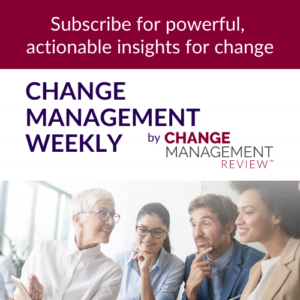ESSAY
How Things Happen: A Cross-Cultural Look at Collective Action
Part 2 – Bottom up Organizing: Sensing Imminence
‘How can I make things happen?’ This is the core question guiding human efforts at organizing collective action. It’s what leaders are expected to do, what MBAs are supposed to train, and what any manager struggles with. Over the course of 2023, Patrick Laudon and Dr. Julien Leyre got together to explore this question. Their year-long conversation resulted in a series of five essays – of which this is the second. (Read first essay.)
From business writing to social media, the present doxa would suggest that our world is moving at a crazier pace than ever. Organizations, old monoliths that they are, face the challenge of keeping up. If they don’t embrace constant change, they will quickly find themselves on the brink of irrelevance.
This is a great pitch to sell change management packages: hectic change out there challenges the rigidity within. But this framing seems to forget that, just as the world keeps changing, so do organizations. They’re organic structures by the very fact that they’re a group of human beings. From one day to the next, you never step in the same company twice, hey?
Many people speak of change as if this was the difficult part: to change a static organization in line with changes in its environment. Yet consider just how much change happens no matter what – technology, regulations, competition, business models, and team. What we should consider a real achievement is to maintain any sort of stability. Keeping a company together for a year is impressive, let alone 150. How can anything exist other than pure chaos then? To approach the question, let’s take an artistic detour.
Crystallizing Change: Mi-e
The Japanese language uses the word ‘Mi-e’ to describe a pivotal moment in Kabuki performance. When the action reaches an apex, the performer freezes for a moment in a posture marking the heightened state of their character. There is a particular energy contained in that moment. When executed well, it gives rise to a flow of applause from the audience.
Kabuki performers punctuate the continuous flow of the play with a few crystallized moments of beauty. The plot is understood through that sequence of fixed images. The peak of art is not fluid movement, but knowing when and how to freeze, and holding that tension. Artistry consists in holding the pose.
The concept of ‘Mi-e’ has a possible origin in Buddhist art. Many temples have statues of Acala, a wrathful deity protecting the dharma, typically represented in a dynamic posture, sword in hand. In this context, Mi-e means ‘arresting a form after a battle or dynamic movement.’
Could the concept of Mi-e be usefully applied to the art of making things happen in human groups? This is how we might think of it. An organization is always in movement. People have joined at different points in time. They regularly interact with each other, with clients and with suppliers. In the process, they access all sorts of information that they interpret based on their own experience. Various mechanisms ensure feedback loops and attunement, guiding the actions and reactions of all the people involved, as well as the mutual correction of their respective models to make sense of the collective reality. In short, people have to fine tune their activity and mental models, so that it matches what’s happening, and what should happen next.
Using Mi-e as an analogy, efficacy consists in regularly providing the members of the organization with a clear picture of ‘where things are at.’ The result is to reset and align individual understandings of the shared situation, and increase the coherence of everybody’s actions. By providing regular ‘images’ of what is happening, it is possible to reinforce a positive trend, or contain a negative one – and therefore guide collective evolution.
Sensing Imminence
The art of organizational Mi-e consists in aligning the narratives of the people involved, in order to improve spontaneous coordination. Let’s explore this in more detail. We propose that efficacy relies on the capacity to capture clear pictures of ‘where the group is at,’ in order to align the action of all participants, increase coherence, and guide results towards a more desirable outcome. For this to work, each of those pictures of ‘where we’re at’ – the shared present – must include a shared sense of the past, guiding towards a shared sense of the future.
Our image of the world is never based purely on whatever ‘is happening right now.’ It is heavily based on what we experienced before. We understand the present in light of the past, and guide our actions on this basis. The past is the frame we use to make sense of the present.
The same applies to any organization we belong to. To make sense of what’s happening, we use whatever model we developed from experience to understand ‘how things work’ in general. We also use our understanding of ‘how things work’ in this specific organization. From those models and experiences, we derive what futures are possible and desirable. In turn, those futures influence our understanding of the present. We pay selective attention to whatever might support or hinder the future we focus on, and tend to neglect the rest. In short, our perceptions of past, present and future are closely intertwined.
One of the major challenges to collective action is that not everyone has the same perception of the present. That is largely because our senses of the past differ. Based on their different life experience, people develop different models to understand ‘how things work in general.’ The level of variation increases with diversity, whether cultural, professional, or otherwise. In addition, people join an organization at different points in time, and work more closely with different suppliers, clients or stakeholders. As a result, they have a different sense of collective history, or ‘how things work around here.’ Not to mention, people have different perceptions of what is possible and what is desirable, which in turn colors their perception of the present.
In short, we do not share the same reality by default. Most of the time, we perceive a situation differently from others. This includes our close colleagues. Our attention is more attuned to different aspects of what’s happening. We give more prominence to different events, factors, or causal chains. The more we interact with different parts of the outside world – even different teams in the same organization – the more this divergence increases. Expectations fall out of tune. We start passing different judgement on what just happened, and making different predictions as to what will happen next. All of which leads to more and more conflicting ideas as to what constitutes the best course of action. Faced with excessive dissonance, some play louder and impose their pitch. Others choose to stop playing. Collective action turns to chaos, or grinds to a halt.
Beyond Control Systems
To contain entropy, organizations tend to develop control systems.[1] Following the wisdom that ‘what gets measured gets done,’ they provide granular targets to guide individual action, in the form of KPIs, OKRs and other performance goals. Yet those control systems themselves quickly get out of tune with a fast-changing external reality. Soon enough, people face a double dissonance: not only between their respective individual narratives, but between their shared control systems and their understanding of the world.
What we call organizational Mi-e takes a different route. Instead of addressing dissonance through controls and escalation, it provides regular pauses during which the members of a collective align their understanding of context. In those ‘frozen moments’, people reconsider what’s important, what’s relevant, and what labels they use to describe what aspects of reality. On this basis, people are able to assess their respective contributions, and redirect their focus, using a coherent taxonomy to describe their activities.
None of this is in itself revolutionary. Yet how often is it prioritized? The relative absence of this practice may well derive from sheer lack of skills. There is an artistry to guiding a collective in this manner. It requires the capacity to synthesize ‘where we are’ in recognizable forms. It also requires the discipline to hold energy – resist the urge to run forward, and take time to test alignment instead.
Our hypothesis, however, is that it derives more fundamentally from an ill-articulated problem. In line with what we called a Western approach to getting things done, most executives will seek ways to better control their people, so that implementation can follow strategy. If the goal is efficacy, another question prevails. The role of executives is to curate the conditions for spontaneous coherent activity. Hence their focus has to shift from external control systems to internalized commitment: what makes individuals actively feel that a collective issue is their problem – and therefore take action to change the situation? This will be the focus of our next essay in this series.
Read the first essay in this series
——-
[1] Those control systems are rarely designed to closely match the internal logic and dynamic of the organization. Rather, they tend to be copied from a standard, often based on the latest fashion – what people happened to learn in their studies or hear at the latest conference. This lack of adequation between the design of control systems and the logic of an organization increases the likelihood that any specific system will quickly fall out of touch with the external world.


